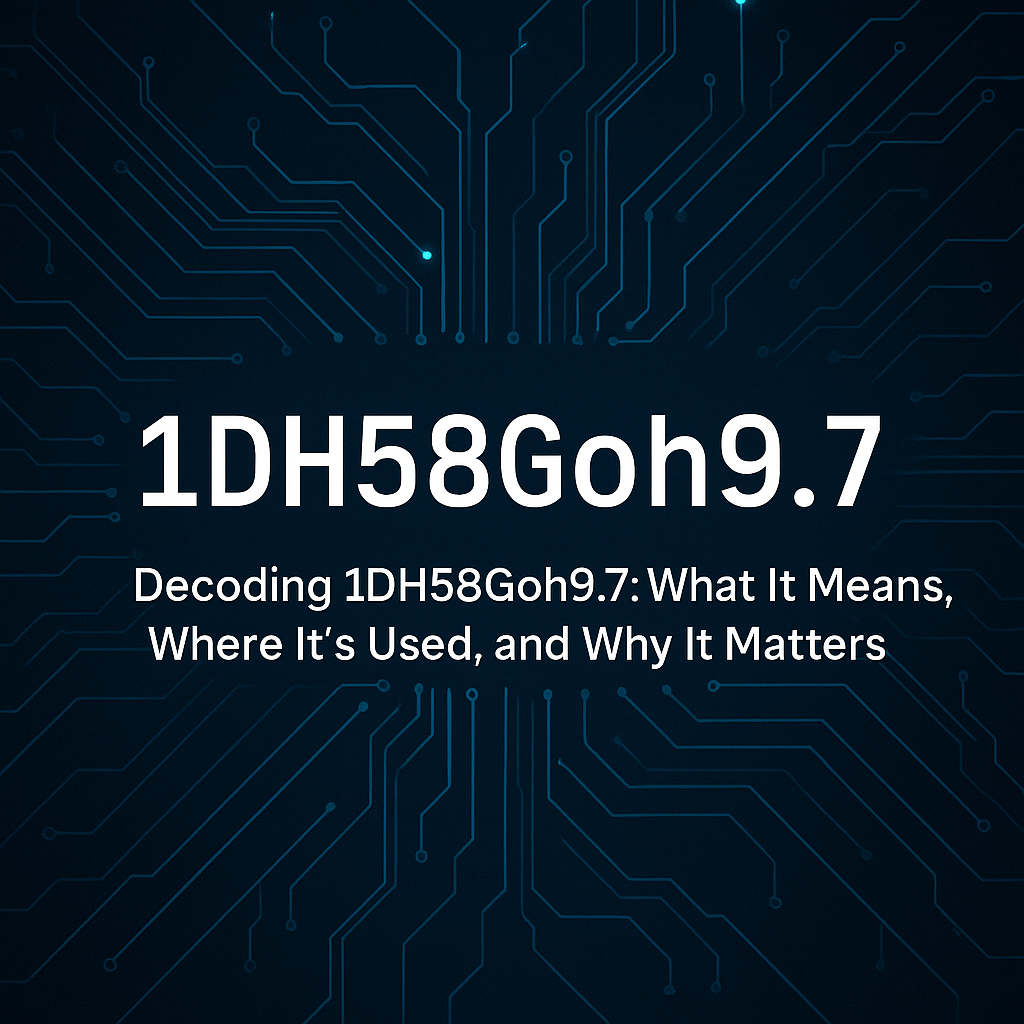In the digital age, we often come across codes, identifiers, or strings that appear to carry significant meaning within a specific system or framework. One such code is 1DH58Goh9.7. While this alphanumeric string may seem random at first glance, its structure suggests it could belong to a range of applications, from technology and coding systems to product identification or encrypted references.
This article explores 1DH58Goh9.7 in depth — what it could represent, where such strings are typically used, and how businesses or developers might encounter and apply it in real-world scenarios.
What Is 1DH58Goh9.7?
1DH58Goh9.7 appears to be an alphanumeric identifier. It contains uppercase letters, lowercase letters, numbers, and a decimal point — all components commonly found in system-generated tags, version numbers, or internal codes.
This kind of format is not accidental. It may indicate:
-
A software version code
-
A product batch number
-
A firmware ID
-
A database record identifier
-
An access key or API reference
Though 1DH58Goh9.7 is not found in any public documentation or standard registry, similar formats are used extensively across industries. Understanding its structure helps us explore its possible purposes and contexts.
Breaking Down the Format
Let’s dissect the parts of 1DH58Goh9.7 to understand its potential makeup.
-
1DH58: This segment may be a prefix or part of a tracking system. It includes digits and uppercase letters, which is common for inventory systems or internal device codes.
-
Goh: This middle portion might indicate a unique category, class, or user-defined segment, possibly signifying a specific department, region, or project.
-
9.7: This is likely a version number, firmware update level, or internal revision number.
Combined, 1DH58Goh9.7 follows a structure similar to that used in version-controlled environments, proprietary tracking systems, and API key formats.
Potential Uses of 1DH58Goh9.7 in Technology
Though it is not a widely recognized code, here are several areas where 1DH58Goh9.7 could logically fit:
Software Versioning
In software development, structured codes like 1DH58Goh9.7 are often used to represent software versions or builds. The 9.7 segment suggests a version number, such as Version 9.7 of a particular application, while the preceding characters might indicate the branch, developer ID, or compilation information.
Device Identification in IoT
In the Internet of Things (IoT), every device needs a unique identifier to communicate with servers securely. A string like 1DH58Goh9.7 could represent a device’s unique ID, including the hardware batch (1DH58), manufacturer reference (Goh), and firmware version (9.7).
Cloud Infrastructure Tags
Cloud services often assign unique identifiers to instances, containers, or storage buckets. For example, AWS, Azure, and GCP use long strings to tag virtual machines and datasets. 1DH58Goh9.7 could be an internal identifier for a cloud deployment or temporary environment.
Product Batches and Manufacturing Codes
Manufacturing systems frequently use codes that look like 1DH58Goh9.7 to tag product batches. This helps trace when and where a product was made, and what version or variation it belongs to.
Why Codes Like 1DH58Goh9.7 Matter
At first glance, alphanumeric codes may seem trivial, but they are a foundational part of data-driven and scalable systems. Here’s why they matter:
-
Unique Identification: They ensure every unit, software copy, or device can be tracked and distinguished.
-
Security: In secure systems, identifiers like 1DH58Goh9.7 are used in encrypted forms to manage access or verify identity.
-
Traceability: In both software and hardware, identifying the version or origin of a component helps troubleshoot, patch, or upgrade systems efficiently.
-
Automation: Automated systems rely on structured IDs to perform tasks such as version updates, remote device checks, and data sorting.
Real-World Examples of Similar Code Formats
To better understand the relevance of 1DH58Goh9.7, let’s compare it with real-world identifiers in different industries:
-
GitHub Commits: Use hashes like
f3c8e9a. -
Software Builds: Identifiers like
v1.0.3567-alphaor2025.04.12-rc2. -
Android Build Numbers: e.g.,
RQ3A.210805.001.A1. -
API Tokens: e.g.,
ak-4trg3XwO7sddJ3G9(structured, partial obfuscation). -
Google Analytics Tracking IDs: e.g.,
UA-12345678-1.
These formats show a pattern: mix of characters, often with a segment indicating a version, user, batch, or region. 1DH58Goh9.7 fits well within this ecosystem.
How to Handle Identifiers Like 1DH58Goh9.7
If you work with systems that generate or use such codes, here are best practices:
Validate Input
Before accepting or processing codes like 1DH58Goh9.7, ensure they meet a predefined pattern (e.g., regex validation). This prevents injection attacks and misuse.
Store Securely
If the code is part of a token, user session, or access system, store it in an encrypted database or secrets manager.
Don’t Hardcode
Avoid hardcoding such identifiers in applications. If they need to be static, define them in configuration files that are outside version control.
Use Metadata
Alongside identifiers like 1DH58Goh9.7, maintain metadata (e.g., creation date, user, status). This enriches system logs and allows for better debugging and analytics.
Could 1DH58Goh9.7 Be Random?
It’s possible that 1DH58Goh9.7 is randomly generated. Developers often use random or pseudo-random code generators for testing, simulation, or anonymizing data. A code with a similar look can be produced using Python or JavaScript.
This confirms that 1DH58Goh9.7 could either be meaningful or generated at random for temporary or illustrative purposes.
Read also: How to Apply xemiwikhiz5654: The Complete Step-by-Step Guide
Final Thoughts on 1DH58Goh9.7
While 1DH58Goh9.7 may not currently be tied to a well-known product, service, or public code registry, its structure and style suggest a potential role in technology, software, security, or device tracking. It’s a great example of how modern systems encode information into strings that look simple but serve complex functions.
Understanding how to interpret, handle, and secure such codes is crucial in today’s interconnected, data-heavy environments. Whether you’re a developer, IT manager, product designer, or just someone exploring system structures, recognizing and respecting the format of identifiers like 1DH58Goh9.7 helps build more secure, reliable, and traceable digital systems.
